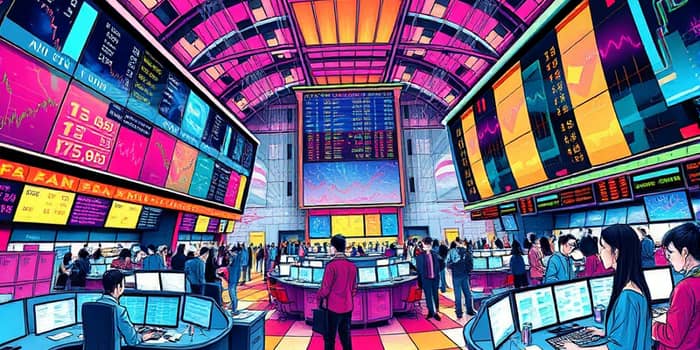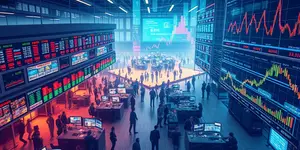
Market microstructure uncovers the inner mechanics of price discovery by examining how individual orders, participants, and rules shape outcomes in financial markets. Far from the headlines about soaring indices or headline-grabbing crashes, microstructure explores the granular processes that determine liquidity, impact trading costs, and influence volatility.
By studying trade execution at the transaction level, market microstructure provides traders, investors, and regulators with the insights needed to optimize strategies, design fair rules, and maintain robust, transparent markets.
At its core, market microstructure is the study of how securities are traded, including the protocols, mechanisms, and behaviors that govern every transaction. It seeks to answer questions such as: How are buy and sell orders matched? What drives bid and ask prices? How does information flow between participants to influence price formation?
Understanding this domain requires examining exchanges, alternative trading systems, dark pools, and the flow of information that drives price discovery. From the way orders are entered into an order book to the moment trades are settled, microstructure shapes both cost and efficiency for all market actors.
Market microstructure revolves around a complex interplay between market participants who perform distinct roles:
Each participant uses different strategies and tools to achieve goals, whether executing a trade at minimal cost or earning profits from fleeting imbalances in supply and demand.
Trading systems support a variety of order types to meet diverse needs. Simple market and limit orders coexist alongside more sophisticated instructions designed to control execution risks.
Advanced participants may use multiple advanced order types such as fill-or-kill or immediate-or-cancel to fine-tune execution. The collection of all active buy and sell orders, the order book, reveals depth and likely future price movements.
Where orders meet matters. Public exchanges like the NYSE and NASDAQ offer transparency and centralized matching. In contrast, dark pools enable large institutional trades away from public view, preserving anonymity but raising concerns about ensuring fair access and transparency.
Choice of venue affects execution quality, slippage, and market impact—a critical consideration for any serious trader.
The dance between buying and selling orders gives rise to bid and ask prices. The difference, known as the bid-ask spread, measures both the cost of trading and market liquidity. Tighter spreads signal deep, liquid markets; wider spreads signal potential illiquidity and higher transaction costs.
Factors influencing spreads include order-processing costs, inventory risk for market makers, competition among liquidity providers, and overall volume. In times of stress, spreads can widen dramatically, reflecting uncertainty and the potential for sudden price swings.
Effective price discovery relies on a continuous flow of orders and information. Delays or information asymmetries can lead to discrepancies, arbitrage opportunities, and, in extreme cases, flash crashes driven by rapid, automated sell-offs.
Technological innovation has transformed microstructure in ways unimaginable a few decades ago. Automated, rules-based trading platforms now execute strategies without human intervention, often reacting in fractions of a second.
High-frequency trading (HFT) can boost liquidity and narrow spreads but also introduces new risks. Flash crashes, latency arbitrage, and concerns about market fairness have prompted regulators to implement safeguards like circuit breakers and minimum resting times for orders.
Meanwhile, dark pools and alternative trading systems continue to grow, accounting for a significant share of US equity volume. The evolving landscape raises questions about fragmentation, price discovery, and the role of hidden liquidity in price formation.
Foundational theories like the Efficient Market Hypothesis (EMH) and Random Walk Hypothesis provide a backdrop for microstructure research. Yet real-world trading also reflects quantitative metrics and behavioral factors, including biases, sentiment-driven swings, and herd behavior.
Information asymmetry remains a central concern—those with faster access or superior analytics can gain an edge, influencing short-term price movements and sometimes challenging notions of market fairness.
Regulators strive to balance innovation with stability, crafting rules that promote transparency, equal access, and resilience. Global trends toward harmonized trading standards and cross-border connectivity aim to deepen liquidity and facilitate capital flows.
Looking ahead, microstructure will continue evolving under the influence of AI-driven analytics, blockchain-based settlement systems, and novel decentralized finance platforms. For market participants, staying informed about these changes is essential to navigate costs, risks, and opportunities.
Market microstructure illuminates the unseen gears and pulleys that drive every trade. By understanding the roles of participants, the nuances of order types, and the impact of technology, traders can optimize execution, control costs, and manage risks more effectively.
Whether you are a retail investor seeking best execution or an institutional strategist designing an algorithm, mastering microstructure principles empowers you to make informed decisions and contribute to healthier, more efficient markets.
Embrace the study of microstructure as a way to unlock deeper insights into market behavior, sharpen your competitive edge, and navigate the ever-changing landscape of global finance with confidence.
References













